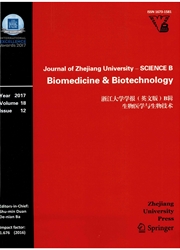

 中文摘要:
中文摘要:
这篇论文论述新奇策略因为嗅觉的感觉神经原(OSN ) 的反应改进由监视 OSN 的增加的回答到有气味的东西基于生物传感器。一个基于 OSNs 的生物传感器根据轻设法解决的 potentiometric 传感器(臀部) 被开发,在哪个老鼠 OSN 在臀部薄片的表面上是有教养的并且用作察觉到元素。LY294002, phosphatidylinositol 3-kinase (PI3K ) 的特定的禁止者,被用来提高 OSN 的回答到有气味的东西。到有或没有 LY294002 的处理的有气味的东西的 OSN 的回答被臀部记录。LY294002 的增加的效果被臀部和这个 OSNs 臀部混合生物传感器的回答高效地记录的结果表演被大约 1.5 褶层被 LY294002 提高。我们断定这个方法能提高 OSNs 臀部混合生物传感器的回答,它可以为简历提供新奇策略在生物传感器的 OSN 的电的信号监视器。这策略可能对为细胞的活动察觉的其它种基于 OSNs 的生物传感器适用,这也被建议,例如微电极数组(MEA ) 和域效果晶体管(联邦货物税) 。
 英文摘要:
英文摘要:
This paper presents a novel strategy for the response enhancement of olfactory sensory neurons (OSNs)-based biosensors by monitoring the enhancive responses of OSNs to odorants. An OSNs-based biosensor was developed on the basis of the light addressable potentiometric sensor (LAPS), in which rat OSNs were cultured on the surface of LAPS chip and served as sensing elements. LY294002, the specific inhibitor ofphosphatidylinositol 3-kinase (PI3K), was used to enhance the responses of OSNs to odorants. The responses of OSNs to odorants with and without the treatment of LY294002 were recorded by LAPS. The results show that the enhancive effect of LY294002 was recorded efficiently by LAPS and the responses of this OSNs-LAPS hybrid biosensor were enhanced by LY294002 by about 1.5-fold. We conclude that this method can enhance the responses of OSNs-LAPS hybrid biosensors, which may provide a novel strategy for the bioelectrical signal monitor of OSNs in biosensors. It is also suggested that this strategy may be applicable to other kinds of OSNs-based biosensors for cellular activity detection, such as microelectrode array (MEA) and field effect transistor (FET).
 同期刊论文项目
同期刊论文项目
 同项目期刊论文
同项目期刊论文
 A non-labeled DNA biosensor based on light addressable potentiometric sensor modified with TiO2 thin
A non-labeled DNA biosensor based on light addressable potentiometric sensor modified with TiO2 thin A novel electrochemical biosensor based on dynamic polymerase-extending hybridization for E.coli O15
A novel electrochemical biosensor based on dynamic polymerase-extending hybridization for E.coli O15 High spatial resolution impedance measurement of EIS sensors for light addressable cell adhesion mon
High spatial resolution impedance measurement of EIS sensors for light addressable cell adhesion mon Ultrasonication on a microfluidic chip to lyse single and multiple Pseudo-nitzschia for marine bioto
Ultrasonication on a microfluidic chip to lyse single and multiple Pseudo-nitzschia for marine bioto 期刊信息
期刊信息
